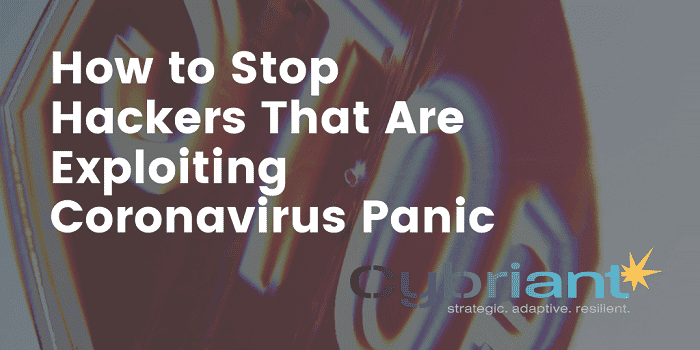In a recent Hacker News story, it was revealed how hackers are exploiting the coronavirus panic. Here are some ways to help prevent those hacks from destroying your business.
Hacker News revealed 7 ways that hackers are exploiting our fears around the Coronavirus. Research is showing that attackers are using Coronavirus-specific lures to reach potential targets.
The attack surface is changing and expanding rapidly as many organizations and business tasks are going digital without much preparation, exposing themselves to more potential threats.
Most of the recent cyberattacks are primarily exploiting the fears around the COVID-19 outbreak-fueled by disinformation and fake news-to distribute malware via Google Play apps, malicious links and attachments, and execute ransomware attacks.
The World Health Organization has seen its share of cyber scammers. See their warning here. We’ve reviewed several ways to defend your enterprise while working from home as well as released a remote worker’s guide.
Here are the 7 ways that hackers are exploiting the Coronavirus panic.
- Mobile Malware
- Email Phishing
- Discounted Off-the-Shelf Malware
- SMS Phishing
- Face Mask and Hand Sanitizer Scams
- Malicious Software
- Ransomware Attacks
The United States Department of Homeland Security (DHS) Cybersecurity and Infrastructure Security Agency (CISA) and the United Kingdom’s National Cyber Security Centre (NCSC) released a joint alert titled COVID-19 Exploited by Malicious Cyber Actors.
Advanced Persistent Threat (APT) groups are using the COVID-19 pandemic as part of their cyber operations. These cyber threat actors will often masquerade as trusted entities. Their activity includes using coronavirus-themed phishing messages or malicious applications, often masquerading as trusted entities that may have been previously compromised. Their goals and targets are consistent with long-standing priorities such as espionage and “hack-and-leak” operations.
Cybercriminals are using the pandemic for commercial gain, deploying a variety of ransomware and other malware.
Both APT groups and cybercriminals are likely to continue to exploit the COVID-19 pandemic over the coming weeks and months. Threats observed include:
- Phishing, using the subject of coronavirus or COVID-19 as a lure,
- Malware distribution, using coronavirus- or COVID-19- themed lures,
- Registration of new domain names containing wording related to coronavirus or COVID-19, and
- Attacks against newly-and often rapidly-deployed remote access and teleworking infrastructure.
How Can You Protect Your Organization?

In our recently released Remote Workers Guide, our CTO Andrew Hamilton describes all the ways Cybriant is protecting our organization while we are working from home because of the COVID-19 outbreak in the US.
In this guide, we discuss tips to secure personal devices and the exact steps to take if you think you have been compromised. Our team deals with highly sensitive data and our remote workers must be vigilant when working remotely. Download the guide and see what steps we’ve taken to prevent our team from cyber attacks.
You’ll also be interested to learn the types of cyber attacks you may see while working from home. Download the guide today and let Cybriant assist your organization during this unique time in our lives.
Recommendations from Cybriant
We typically recommend starting with an assessment so our team has a better grasp of where you are in your security strategy. We offer all assessments including:
- Risk Assessment
- Gap Analysis
- Penetration Test
- Mobile Security Risk Assessments
Find out more about our assessments here.
Mobile Security Risk Assessment
Our comprehensive mobile security risk assessment will allow you to evaluate the risk presented to the organization by mobile phones and tablets, evaluate potential omissions in policies, documentation, and implementation. This assessment will also help evaluate the impact of mobile device policy on diverse geographic and economic user groups. Plus, we’ll be able to recommend actions to better secure and align mobile devices to business practices.
Our comprehensive mobile security risk assessment will include the following:
- Evaluate risk presented to the organization by mobile phones and tablets
- Evaluate potential omissions in policies, documentation, and implementation
- Evaluate the impact of mobile device policy on diverse geographic and economic user groups
- Recommend actions to better secure and align mobile devices to business practices
This is an incredibly important step to take while your enterprise is working from home. Learn more about our Mobile Security Risk Assessment here.
Managed Detection and Remediation (MDR)
Antivirus isn’t enough to protect your endpoints.
The fact is that cyberattacks on endpoints are increasing rapidly in complexity and numbers. With digitization continuing to transform industries, devices in huge numbers are likely to be compromised.
To mitigate the risk of compromised systems, you need an immediate response, enhanced security tools, and a team of experts on your side that can guide you through the entire remediation process.
With MDR from Cybriant, our security analysts monitor your endpoints 24/7 and filter out false positives. You’ll receive the alerts when relevant threats are detected along with advice and insight from our cyber security team to help you mitigate and respond to the threat.
Learn more about MDR from Cybriant.
Mobile Threat Defense
Corporate infrastructures have been venturing into the BYOD (Bring Your Own Device) world for years often without knowing it. Conditional restrictions are often not in place to prevent access to corporate data reposited in email, SharePoint, calendaring, corporate contacts, and other applications. And even in cases where conditional restrictions may exist, the usage of mobile threat defense software may not be present or utilized on the device.
Contrastingly companies will often stringently secure their corporate laptops and desktops with MDR solutions, SIEM agents, and vulnerability management solutions. The difference in approaches to BYOD devices versus corporate-managed devices is troubling because BYOD devices can often access the same confidential data but without similar safeguards. With the recent string of major vulnerabilities discovered in both the Android and Apple iOS ecosystems, it’s becoming more apparent that any device that can access corporate data is a potential avenue for attack.
With two levels of service, Cybriant’s Mobile Threat Defense (MTD) service is an affordable way to protect the majority of your workforce, contractors, and BYOD users. It provides a baseline of protection and assurance that your mobile devices will be secured against common threats and attack vectors.
Learn more about our Mobile Threat Defense offerings
Related: What Hackers Know About Fileless Malware (And You Should Too)



